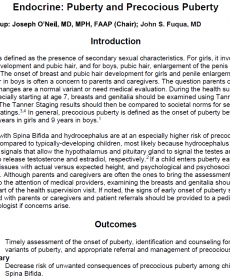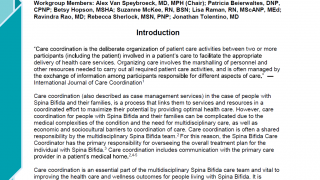Workgroup: Joe O’Neil, MD (Chair); John S. Fuqua, MD
Introduction
Puberty is defined as the presence of secondary sexual characteristics. For girls, it involves breast development and pubic hair, and for boys, pubic hair, enlargement of the penis and testicles. The onset of breast and pubic hair development for girls and penile enlargement and pubic hair in boys is often a concern to parents and caregivers. The question parents often ask is if the changes are a normal variant or need medical evaluation. During the health supervision visit, especially starting at age 7, breasts and genitalia should be examined using Tanner Staging. The Tanner Staging results should then be compared to societal norms for sexual maturity ratings.3,4 In general, precocious puberty is defined as the onset of puberty before the age of 8 years in girls and 9 years in boys.1
Children with Spina Bifida and hydrocephalus are at an especially higher risk of precocious puberty compared to typically-developing children, most likely because hydrocephalus removes inhibitory signals that allow the hypothalamus and pituitary gland to signal the testes and ovaries to release testosterone and estradiol, respectively.2 If a child enters puberty early there could be issues with actual versus expected height, and psychological and psychosocial problems. Although parents and caregivers are often the ones to bring the assessment of puberty to the attention of medical providers, examining the breasts and genitalia should be a routine part of the health supervision visit. If noted, the signs of early onset of puberty should be discussed with parents or caregivers and patient referrals should be provided to a pediatric endocrinologist if concerns arise.
Outcomes
Primary
- Timely assessment of the onset of puberty, identification, and counseling for normal variants of puberty, and appropriate referral and management of precocious puberty.
Secondary
- Decrease risk of unwanted consequences of precocious puberty among children with Spina Bifida.
0-11 months
Clinical Questions
- How often should weight and length be measured in ages 0-11 months?
Guidelines
- Monitor and document weight and length closely at every health supervision visit. Length should be measured with a length measuring board.2 (clinical consensus)
- Perform a complete physical exam, including of the breasts and genitalia, at each health supervision visit.2 (clinical consensus)
- Document all positive and negative findings of the physical exam. (clinical consensus)
- Discuss the outcomes of the evaluation with the parents or caregivers and ask them if they have any concerns. (clinical consensus)
- Consider a referral to an endocrinologist if abnormal signs of puberty are observed. (clinical consensus)
1-2 years 11 months
Clinical Question
- What effect does hydrocephalus have on early onset of puberty?
Guidelines
- Monitor and document weight and length closely at every health supervision visit. Length should be measured using a length measuring board.2 (clinical consensus)
- Perform a complete physical exam, including of the breasts and genitalia, at each health supervision visit.2 (clinical consensus)
- Document all positive and negative findings of the physical exam. (clinical consensus)
- Discuss the outcomes of the evaluation with the parents or caregivers and ask them if they have any concerns. (clinical consensus)
- Consider a referral to an endocrinologist if abnormal signs of puberty are observed. (clinical consensus)
3-5 years 11 months
Clinical Questions
- What is the best practice for detection and management of early puberty?
- Should every child with early signs of puberty be referred to an endocrinologist?
Guidelines
- Monitor and document weight and height velocity closely at every health supervision visit. Height should be measured (if possible) using a stadiometer. Often there may be difficulty assessing height due to inability to stand, scoliosis or contractures. In these cases, arm span or another appropriate parameter may be used. Care should be taken to use the same parameter at subsequent visits.2 (clinical consensus)
- Perform a complete physical exam, including of the breasts and genitalia, at each health supervision visit.2 (clinical consensus)
- Document all positive and negative findings of the physical exam. Consider referral to a pediatric endocrinologist if abnormal signs of puberty are observed. Abnormal signs could include progressive breast development over a 4- to 6-month period of observation or progressive penis and testicular enlargement, especially if accompanied by rapid linear growth. Children exhibiting these true indicators of early puberty need prompt evaluation by an appropriate pediatric endocrinologist.1
- Discuss the outcomes of the evaluation with the parents or caregivers and ask them if they have any concerns. (clinical consensus)
6-12 years 11 months
Clinical Questions
- Does intervening in pubertal development affect a child’s self-perception?
- What is the psychological impact on the initiation of puberty on the parent/caregiver versus the child?
Guidelines
- Monitor and document weight and height velocity closely at every health supervision visit. Height should be measured (if possible) using a stadiometer. Often there may be difficulty assessing height due to inability to stand, scoliosis or contractures. In these cases, arm span or another appropriate parameter may be used. Care should be taken to use the same parameter at subsequent visits.2 (clinical consensus)
- Perform a complete physical exam, including of the breasts and genitalia, at each health supervision visit.2 (clinical consensus)
- Discuss the outcomes of the evaluation with the parents or caregivers and ask them if they have any concerns. (clinical consensus)
- Consider a referral to a mental health professional if the child is having psychosocial issues with his or her growth or development. (clinical consensus)
13-17 years 11 months
Clinical Question
- How does puberty affect the self-perception of the 13-17-year-old with Spina Bifida?
Guidelines
- Monitor and document weight and height velocity closely at every health supervision visit. Height should be measured (if possible) using a stadiometer. Often there may be difficulty assessing height due to inability to stand, scoliosis or contractures. In these cases, arm span or another appropriate parameter may be used. Care should be taken to use the same parameter at subsequent visits.2 (clinical consensus)
- Perform a complete physical exam, including of the breasts and genitalia, at each health supervision visit. If the individual is more comfortable with a provider of the same gender, offer that the exam be completed by a provider of the same gender.2 (clinical consensus)
- Document all positive and negative findings of the physical exam with the parent or caregiver. (clinical consensus)
- Discuss the outcomes of the evaluation with the parents or caregivers and ask them if they have any concerns. (clinical consensus)
- Refer the child to a pediatric endocrinologist if there is clear evidence of abnormal timing, tempo, or sequence of pubertal development. (clinical consensus)
- Consider a referral to a mental health professional if the child is having psychosocial issues with his or her growth or development. (clinical consensus)
18+ years
Clinical Questions
- How has completing puberty affected the individual’s relationships with others?
- Has the individual’s self-perception changed as a result of completing puberty?
Guidelines
- Perform a complete physical exam, including of the breasts and genitalia, at each health supervision visit.2(clinical consensus)
- Document all positive and negative findings of the physical exam with the patient or caregiver.2 (clinical consensus)
- Discuss the outcomes of the evaluation with the patient and also with parents or caregivers, if appropriate, asking them if they have any concerns. (clinical consensus)
- Consider a referral to a mental health professional if the individual is having psychosocial issues with their growth or development. (clinical consensus)
- Discuss sexual health issues and make appropriate referrals to urologists, gynecologists or other sub-specialists such as endocrinology, adolescent medicine, genetics or others, as clinically appropriate. (clinical consensus) (Men’s Health Guidelines, Women’s Health Guidelines, Sexual Health and Education Guidelines)
Research Gaps
- What effect does puberty and precocious puberty have on self-perception and psychological development of an individual with Spina Bifida?
- How often should weight and length be measured in the 0-11-month age group?
- What effect does hydrocephalus have on early-onset of puberty?
- Is there an optimal age to intervene when precocious puberty is identified?
- What is the best practice for counseling children and parents/caregivers during puberty or precocious puberty?
- What is the best practice for detection and management of early puberty?
- What is the psychological impact on the initiation of puberty on the parent/caregiver versus the child?
- Does intervening in pubertal development affect a child’s self-perception?
- How has completing puberty affected the individual’s relationships with others?
- Has the individual’s self-perception changed as a result of completing puberty?
References
- Kaplowitz P, Bloch C, Section on Endocrinology. Evaluation and Referral of Children with Signs of Early Puberty. Pediatrics. 2016; 137(1): e20153732.
- Hagan JF, Shaw JS, Duncan PM, eds. Bright Futures: Guidelines for Health Supervision of Infants, Children, and Adolescents. Fourth Edition. Elk Grove Village, IL; American Academy of Pediatrics; 2017
- Marshall WA, Tanner JM. Variations in pattern of pubertal changes in girls. Arch Dis Child 1969; 44:291.
- Marshall WA, Tanner JM. Variations in the pattern of pubertal changes in boys. Arch Dis Child 1970; 45:13.
Tags

